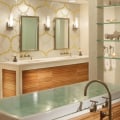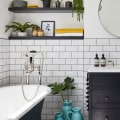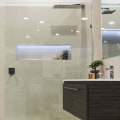Contemporary style bathroom, general table of bathroom styles · Most popular bathroom faucet. In other words, these data present the most popular bathroom styles. Below is a table and graphs that establish the percentage that each style is used in the bathroom decoration. Below is a general table of bathroom styles.
The links take you to the photo gallery of that style of bathroom. Clean lines, clutter-free expansions of open spaces and minimalist ornaments are all hallmarks of contemporary bathrooms. Expect to see plenty of polished hardwood, metal accents, and a clean and simple color palette in this type of decor. Free of clutter, ornaments and excessive ornamentation, the Scandinavian style is reminiscent of contemporary style bathrooms.
From repurposed vanities to terrazzo sinks, modernize your bathroom with the help of these trendy design ideas. The pandemic has only increased the owners' desire to rest and relax, making soaking tubs a superior bathroom feature for next year. According to a study of Houzz bathroom trends, flat-bottomed freestanding bathtubs will be more popular than models with more decorative legs or bases. Kim Frechette, Americh's national sales manager, says these simple bathtub silhouettes, especially in white, work well in any bathroom style.
The classic decor focuses on the use of simplistic bright colors such as simple colors such as white and soft gray to bring a clean feeling to the bathroom space. Usually, this is further accentuated by gold, brass or platinum ornaments. This style uses porcelain, marble and acrylic for its accessories and focuses on tiles and bricks for walls. And speaking of accessories, this style mainly uses freestanding bathtubs with legs, freestanding washbasins, carpets with simple floral patterns or contrasting tiles.
Lastly, classic bathrooms usually contain a large decorative mirror with floral ornaments and lighting provided by a chandelier or chandelier. Modern decor uses sleeker designs to create a clean design that aims to save space without losing any functionality. The modern design uses natural stone, stone resin, wood, glass and composite materials to achieve its look. Common colors include black, white, gray and light brown colors, colors that emulate the look of natural stone and wood.
Fittings include a freestanding or built-in bathtub and a walk-in shower. Washbasins and vanities are usually wall-mounted and “floating” to save space and look more modern. Towels and rugs usually match the color of accessories and walls or have geometric shapes to add a modern touch. Finally, lighting is usually more varied in a modern bathroom, using almost any style that suits it.
Contemporary bathrooms combine sensibilities of classic and modern design. Contemporary bathrooms often use clean lines, symmetrical geometric patterns, and hard angles in their design. Contemporary bathrooms use similar materials, such as modern design, mainly natural stone, stone resin, granite and stainless steel. They focus on natural and artificial materials that complement each other and provide a visual contrast.
Common elements of a contemporary bathroom include a separate sink between vanities or wood or metal cabinets. This style contrasts modern and classic designs to create your own unique aesthetic. Attractive for a more rustic sensibility, rustic-style bathrooms are more in line with farmhouse life. This style uses wood paneling for both its floors and walls to create the feel of a farmhouse.
Common colors with this style include light and dark browns to simulate the look and feel of different types of wood. Freestanding bathtubs and vanity-mounted sinks are the accessory of choice for this style, invoking a sense of escape for the user. Lighting should be rustic, so your lighting should simulate the look and feel of lanterns. A maritime theme is perfect for your ocean getaway.
The common colors with nautical style are light blues, blue greens, whites combined with blue and anything that resembles the ocean and the sky as a contrast. Freestanding porcelain or acrylic bathtubs are the accessory of choice, which match well with vanity-mounted sinks to provide a classic feel. Materials for this style would include wood, natural stone and porcelain. Your decor should have a maritime theme, so items such as boats, shells, ocean creatures and objects you can find on the beach.
Traditional bathroom designs are quite similar to classic options, using familiar designs to create a universal charm. These bathrooms often cover a wide range of colors and patterns with classic approaches, such as porcelain clawfoot tubs, which use marble and stainless steel for sink stands and vanities. Traditional design emphasizes bold design by employing classic materials such as porcelain, acrylic and marble in unique shapes. The colors of the traditional bathroom configuration tend to be primary colors, such as bright colors, whitish, gray, brown and black colors.
Vintage bathroom designs tend to use elaborate and whimsical wall patterns to create a vintage feel. These bathrooms are typically classic, employing similar aspects, such as fiberglass or acrylic bathtubs and pedestal-style basins. The distinctive feature of vintage-style bathrooms is a division between floral and intricate wall patterns and tiles for the wall and sometimes floors. The vintage-style bathrooms are always in primary colors, typically green, white and light red.
Farm-to-cottage or rustic-style bathrooms, farmhouse bathrooms use earthy color palettes to create a sense of comfort. Wood fixtures, hardwood floors and accents add a unique rustic vibe. These can be further extended to lighting fixtures and accents for paintings and mirrors. A bucket sink would help bring it all together with a simple freestanding bathtub.
Craftsman bathrooms use handcrafted items such as drawers, cabinets, vanities, windows, and sometimes even accessories. This style of bathroom retains much of the charm of the classic bathroom, but uses elements it has created for a more rustic and homely feel. Since many of the elements are constructed of wood, simple elements such as brass, nickel and copper details are all that is needed. Industrial bathrooms aim to exemplify the beauty of natural design.
These bathrooms use normally unattractive features, such as exposed pipes, ducts, tubes, and cables to create an unfinished design that seems to blend in with the concrete jungle. The traditional material for this style includes steel, other metals and concrete. Brick is a common material for walls, and corrugated steel panels are another great option for creating the perfect industrial environment. Exposed pendant lights, metal mirrors, and even a concrete bathtub can also add something good to this aesthetic.
Another addition to the classic bathroom design, Hampton style bathrooms are typically constructed with white marble and have a touch of blue accent. They share many features of traditional design, but tend to use high-end materials. Countertops are usually marble or granite, high gloss tile, marble tile and shaker style cabinets. Freestanding bathtubs are the last element to bring this bathroom together completely, giving you plenty of space to build and make it your own.
As long as the accessories share the same white aesthetic. For this reason, wood-paneled, cabin-style bathrooms are supposed to invoke the feeling of a vacation away from home. This style uses classic pedestal sinks to contrast with bright color schemes and natural lighting. Many of the fixtures of a country house should be substantial and add weight, since the cottage uses more natural elements such as sunlight, so brass or copper fittings work very well here.
Countertops are usually made of natural or stained wood, as they see a lot of sunlight and can add a good visual complement. Good pairings include bold patterns and colors on bedding, tiles, shower curtains and aged furniture with a very vibrant backdrop. Rustic bathrooms create a classic touch with a wooden base. Stained wood and various types of wood help create a home away from home.
Natural tones such as greens and golden browns are great complements with wooden wall panels and floor tiles. In the case of accessories, wrought iron, stainless steel and copper contrast perfectly with the natural elements of the wooden design. Curtains with greater durability, such as plaid or buffalo, make excellent combinations. European bathrooms use a transitional design, combining elements from different eras to provide their own blend.
They use materials such as stone or natural wood for countertops and basin pedestals. For accessories, natural wood and wrought iron are popular options, as they help complement the design and can be modern or traditional, depending on the other accessories. Scandinavian bathrooms are generally spacious and minimalist. Striving for that Nordic touch, these bathrooms use wood and marble paneling on much of their walls and floors.
Its colors are generally more muted, with white being the most common, usually combined with wooden details. Freestanding bathtubs are the popular bathtub of choice, offering more free space and matching the more minimalist design option. Geometric rugs, details and towels are a great combination here to match the choice of minimalist design. A Scandinavian bathroom is often seen as a modern design, as there is less wasted space and they can easily be bathed in a small space without having to search for tight space.
Japanese bathrooms strive to efficiently use the space around them. This involves using a large number of modern designs to save space. Common colors include different shades of brown and different aspects of white and gray to convey cleanliness. Wood and natural stone are common materials for Japanese-style bathrooms, as they are generally of higher quality and provide a calm aesthetic.
Soaking tubs are the bathtub of choice here, as they offer the benefits of a freestanding bathtub and save space. The aesthetics of Japanese bathrooms are more in line with nature, using symmetrical geometry to provide an attractive space that does not take up too much space. Whichever color you choose, look for new durable paints to help your bathroom stay cleaner longer. Abundant flowers on an oversized scale fill this bathroom with swooning romance, while gold details and delicate accessories accentuate the bold space to perfection.
In this space designed by Peti Lau, the bathroom and bedroom share one wall, so the connecting fireplace provides warmth, style and romance on both sides. Very masculine and European-style (note the toilet with bidet), this bathroom is modern, dark and moody. While fireplaces aren't exactly frequent flyers in the bathroom, we're discovering this as an unexpected statement. With hanging eucalyptus trees, a recycled turquoise sink and clean bedding, this farmhouse bathroom designed by Leanne Ford goes beyond the dreamy.
When designing your bathroom, be sure to implement your own style and create a theme that appeals to your own sensibilities. Wall mount bathroom vanities come in a variety of configurations, from a complete unit with countertop, sink, and storage base as a freestanding vanity without legs to partial sets and completely separate pieces. With a traditional bathtub, striped shower curtain, penny tile floors, and bold artwork, this bathroom adds a modern touch to Old World style. With warm marble floors and romantic pink marble surfaces, this Hecker Guthrie-designed bathroom is more like a 5-star spa.
Clean lines, simple shapes and traditional tap touches make this bathroom something that will stay classic for years to come. The soothing tones of this bathroom create the perfect place to get a little R&R at the end of a long day. Every room at designer Fitz Pullins's home in Florida is brimming with fun, including this bathroom with monkey print wallpaper. .
.



Leave Message